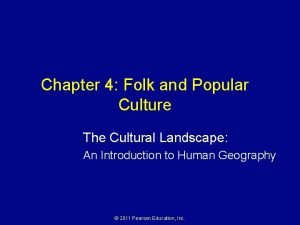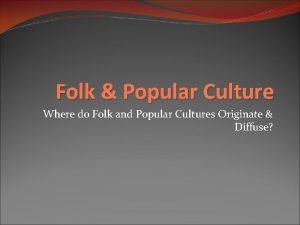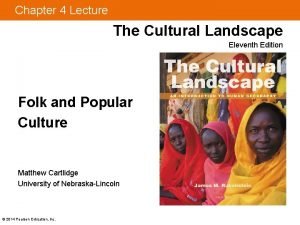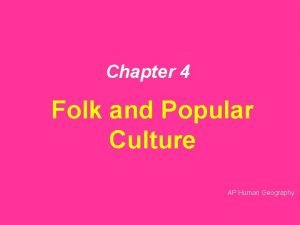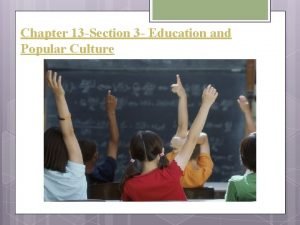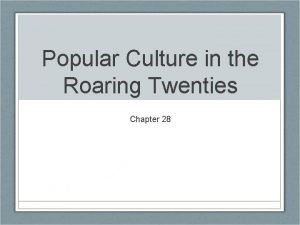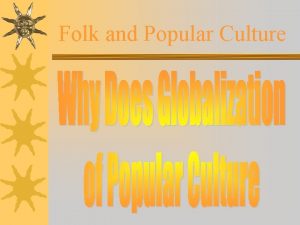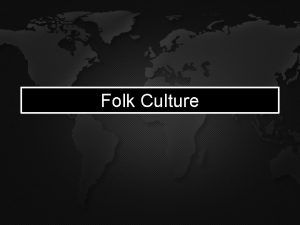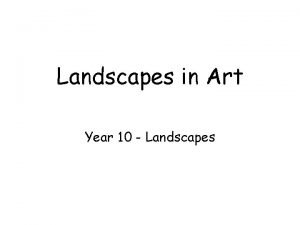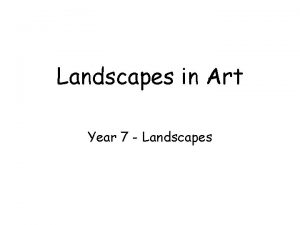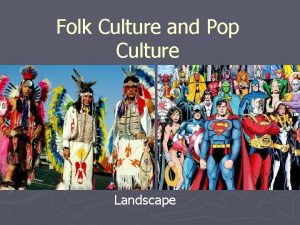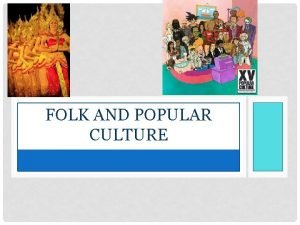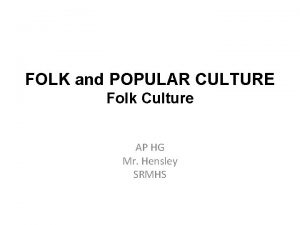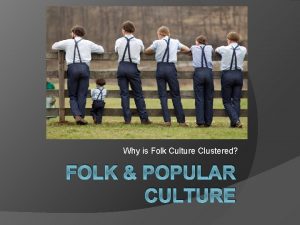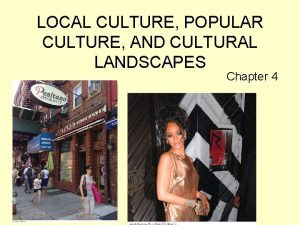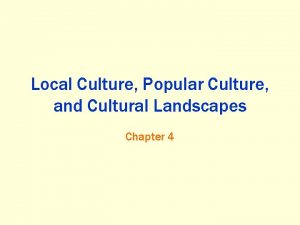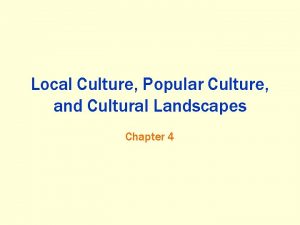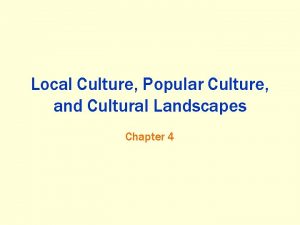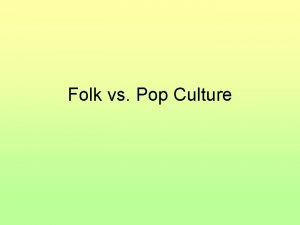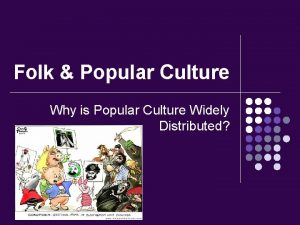Folk Culture Popular Culture and Cultural Landscapes Chapter

















- Slides: 17

Folk Culture, Popular Culture, and Cultural Landscapes Chapter 4

Culture is a group of belief systems, norms, & values practiced by a group of people. A group of people who share common beliefs can be recognized as culture in one of two ways: 1. the people call themselves a culture 2. other people label people as a culture. Academics has labeled culture groups as folk cultures or popular cultures.

Beijing, China 2004 Women with ox cart in Myanmar Folk culture, also known as local culture, is small, incorporates a homogeneous population, is typically rural, and is cohesive in cultural traits. Popular culture is large, incorporates heterogeneous populations is typically urban, and experiences quickly changing cultural traits.

Turkish camel market Folk culture is a group of people in a particular place who see themselves as a community, who share experiences, customs, traits, and work to preserve those traits to claim uniqueness and distinguish themselves from others. People of folk cultures rely primarily on religion to maintain their belief systems. By isolating themselves in rural areas, it makes it easier to keep external influences on the outside.

The material culture of a group of people includes the things they construct, such as art, houses, clothing, sports, dance, and foods. Nonmaterial culture includes the beliefs, practices, and values of a group of people. What members of a folk culture produce in their material culture reflects the beliefs and values of their nonmaterial culture. Other aspects of nonmaterial culture include dialects, religions, and worldviews.

Unlike folk culture, popular culture can change in a matter of days or hours. Pop culture is practiced by a heterogeneous group of people; people across identities and across the world. Like folk culture, pop culture includes music, dance, clothing, food preference, and religious values. The main paths of diffusion of pop culture are the transportation, marketing and communication networks that interlink vast parts of the world.

Example: • New fashion such as Dior • • • Extreme cutout sandal, finds its way onto Paris runways Within days it will be seen on models in New York Days later it will be seen on celebrities Within weeks it makes its way into magazines like In Style In the same time frame it will be found in upscale stores A few weeks after that we will see knockoffs at our local malls Pop culture (esp. fashion trends) spread quite quickly through the interconnected world. It is a classic case of hierarchical diffusion. Key cities such as Milan, Paris & New York are the hearth. The next tier of places includes the major fashion houses in world cities. Finally, the suburban mall receives the innovation. Hierarchical diffusion can also occur through a hierarchy of people.

Example: may go to a store like Wal -Mart and see Amish dressed in distinctive folk clothing in the midst of pop culture. Example: traditions like painting henna on one’s hands is carried from centuries-old customs of folk cultures to the global pop culture. Geographers have considered whether or not folk and pop culture are on opposite sides of the continuum. We do not see folk and popular cultures as being ends of continuum, rather we see both operating on the same plane, affecting people and places in different ways across different scales.

How are folk cultures sustained? During the 1800 s and into the 1900 s, the U. S. government had an official policy of assimilation • when ppl. lose their culture traits as they come in contact with another society. The U. S. wanted to assimilate indigenous people into the dominant culture. In this case to make American Indians into “Americans” rather than “Indians. ” • U. S. awarded the most “American” Indians with citizenship and paid jobs Canadians, Australians, Russians and other colonial powers adopted similar policies toward indigenous peoples, using schools, churches, and government agents to discourage native practices. • Today, several churches and governments have apologized for assimilation policies.

How is assimilation represented here?

Austrailia Aboriginal children were taken from their homes and placed into residential schools where they were taught the new white English culture. • Lasted from the 1800 s to the late 1960 s

Rabbit Proof Fence http: //www. youtube. com/watch? v=r. Bjkydq. ADg


How are folk cultures sustained? Folk cultures are sustained through customs. A custom is a practice that a group of people routinely follows. People have customs regarding all parts of their lives, from eating and drinking to dancing and sports. To sustain a folk culture, people must retain their customs.

Folk cultures have to work to avoid cultural appropriation, the process by which other cultures adopt customs and knowledge and use them for their own benefit. In our globalizing world, cultural appropriation is a major concern for folk cultures because aspects of cultural knowledge are being privatized by people outside the folk culture and used to accumulate wealth or prestige. (Example: Crazy Horse Beer got sued)

Some local cultures have successfully built a place to practice their customs within a major city by constructing tight-knit ethnic neighborhoods. For example the Italian Americans in New York City. Having their own ethnic neighborhoods enables members of a local culture in an urban area to set themselves apart and practice their customs. Schools, houses of worship, food stores and clothing stores all support the desires of members of the local culture.

Credits De Blij, H. J, Erin Fouberg, and Alexander Murphy. Human Geography People, Place, and Culture 9 th Edition. New Jersey: Wiley, 2009 http: //imarketu. wordpress. com/2009/07/21/starbucks-free-pastry-day -twitter-win/
 Folk culture and popular culture venn diagram
Folk culture and popular culture venn diagram Popular culture examples
Popular culture examples Homework due today
Homework due today Folk and popular culture
Folk and popular culture Folk culture origins
Folk culture origins Folk and popular culture
Folk and popular culture How do the origins of folk and popular culture differ
How do the origins of folk and popular culture differ How does folk culture diffuse
How does folk culture diffuse Why is access to folk and popular culture unequal
Why is access to folk and popular culture unequal Ap human geography songs
Ap human geography songs Popular culture ap human geography
Popular culture ap human geography Chapter 5 glaciers oceans and landscapes
Chapter 5 glaciers oceans and landscapes Chapter 13 section 3 education and popular culture
Chapter 13 section 3 education and popular culture Chapter 13 section 3 education and popular culture
Chapter 13 section 3 education and popular culture Landscapes and landforms booklet
Landscapes and landforms booklet Landscapes and landforms
Landscapes and landforms Chapter 28 popular culture in the roaring twenties
Chapter 28 popular culture in the roaring twenties Chapter 19 section 1 postwar america
Chapter 19 section 1 postwar america



